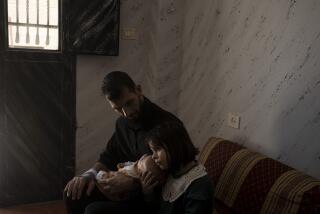Reforms in Place at Abu Ghraib
ABU GHRAIB, Iraq â In a stark room with plywood walls, a prisoner in a yellow jumpsuit sits in a plastic chair, eyes fixed on his interrogators. He is telling a long story, stopping occasionally to drink from a Coke can on the table next to his chair, then resuming his tale.
Watching the interrogation through a closed-circuit television, Army Chief Warrant Officer Daniel Adkins, an interrogator at Abu Ghraib prison, says the quality of information from Iraqi detainees often does not match the quantity.
âTheyâre always very chatty,â he says. âItâs just that the subject of what they like to talk about is not always what weâre looking for.â
More than four months after photos documenting abuse of detainees and harsh interrogation methods at Abu Ghraib burst into public view, sparking an international scandal and more than a dozen official investigations, the work of trying to glean useful intelligence from prisoners continues 20 hours a day at this 260-acre compound west of Baghdad.
But officers and enlisted personnel insist that the prison has righted itself.
After a period of leadership failures, overcrowding, murky chains of command, and vague orders to âget better intelligenceâ from detainees, U.S. officials say management has been improved and prisoners are being treated fairly.
Techniques such as depriving prisoners of sleep, putting hoods over their heads, forcing them to stand naked and using dogs to intimidate them have been banned. Crowding has been eased.
It is a very different picture from the one presented in two major reports on prisoner abuse released last week. The investigation into the 205th Military Intelligence Brigade by Army generals and the independent report chaired by former Defense Secretary James R. Schlesinger both documented a badly managed prison that degenerated into chaos last year while the Iraqi insurgency grew deadlier by the day.
The generals found that 41 intelligence officers, CIA officials, military police and civilian contractors committed or condoned abuses, in addition to seven MPs already charged. Schlesingerâs panel said the abuses resulted from a climate of neglect, overcrowding and command failures.
In contrast to those grim portraits, Camp Ganci, a makeshift tent city on the prison grounds once inhabited by 5,200 detainees, now houses only 523 inmates. Most of the remaining 1,400 inmates at Abu Ghraib have moved to a newer encampment, Camp Redemption, where they are segregated based on the level of perceived security risks.
The drawdown, says Army Maj. Gen. Geoffrey D. Miller, who assumed responsibility for U.S. prisons in Iraq in April, has been made possible in part by cutting the time prisoners wait to appear before the Review and Release Board, where many are judged to be of little intelligence value and are set free.
The current average wait is about 40 days, down from more than 200. Also, far fewer detainees are being funneled into the prison now.
Miller also says he has established clear lines of authority between military police -- who are in charge of maintaining order at the facility -- and interrogators. Pentagon investigators cited poorly defined chains of command at Abu Ghraib and a decision to put MPs under the âtactical controlâ of interrogators as factors that contributed to the abuse of prisoners.
Although MPs now play no active part in interrogations, Miller argues that it is essential for the guards to take part in âpassive intelligence gathering.â Once a week, MPs meet with interrogators to share intelligence about how specific prisoners behave, whom they interact with, and what they may have revealed during their daily routine.
Miller has brought in a team of officers with experience in Army corrections, hoping to create a uniform system of detention practices and training for MPs and interrogators.
Each three-person interrogation team now receives two hours of extra training each week, and interrogations are constantly monitored by officers. MPs at Abu Ghraib now undergo a training regimen that didnât exist last year.
Yet even maintaining order can still be problematic. On Aug. 18, a large fight erupted, involving more than 200 detainees. According to a statement from the military, guards intervened using lethal force, and when it was all over, two detainees were dead and five were injured.
âItâs a constant monitoring process to keep them from beating each other up,â says an MP who gives his name as Sgt. Osbeck. âYou have Shias on one side, Sunnis on the other, and other people in the middle that nobody likes.â
Few international human rights organizations have been able to independently judge the reforms at Abu Ghraib firsthand. The International Committee of the Red Cross has visited the prison, but it does not make its reports public.
Some groups say the U.S. detention system in Iraq still lacks transparency, and note that there are no complete lists of those in U.S. custody and why they are detained, that it still takes more than a month for detainees to have their status reviewed.
âDetainees can still languish for long periods of time without having the opportunity to challenge their detention,â said Alistair Hodgett, a spokesman for Amnesty International in Washington. âAnd theyâre certainly not able to challenge their detention in a legitimate court.â
Other human rights advocates question whether Miller should even be running Abu Ghraib, because he also is being investigated in the prison scandal, based on his visit to the facility in August 2003 at the Pentagonâs behest.
During his visit, Miller was asked to recommend ways to get better âactionableâ intelligence from detainees for the U.S. counterinsurgency effort. At the time, Miller commanded the U.S. detention facility at Guantanamo Bay, Cuba -- where former detainees also have alleged abuse.
Intelligence officers implicated in the scandal and Brig. Gen. Janis Karpinski, former commander of MPs in Iraq, have alleged that Miller recommended harsh interrogation practices that ultimately led to the prisoner abuse at Abu Ghraib.
Miller defends the recommendations his team made and is confident that the investigations will clear him.
For instance, he says that when he recommended that MPs set âthe conditions for successful exploitationâ of detainees -- advice some investigators have criticized -- he had in mind only the kind of âpassive intelligence gatheringâ he has now put in place.
âAll of the recommendations were made within the scope of whatâs right,â Miller says. âAnd the investigations will bring the facts out.â
Both of last weekâs reports exonerate Miller of any direct role in the actual prisoner abuse. But at the same time, the investigation by Army Lt. Gen. Anthony R. Jones and Maj. Gen. George R. Fay said that Millerâs recommendations helped create the confusion that spread through the prison over what interrogation techniques were permissible.
For instance, Miller suggested that military dogs be used at Abu Ghraib to guard the prisonâs perimeter and to help keep control of the prisoners. The Jones-Fay report said that the 205th Military Intelligence Brigade commander, Col. Thomas M. Pappas, misinterpreted this recommendation to mean that dogs ought to be used during interrogations.
In Millerâs view, responsibility for the abuse falls on the commanders at Abu Ghraib, and though he has not named names, it is clear he believes Karpinski bears much of the blame.
âIt was an enormous failure of leadership,â Miller says. âLeaders abrogated their responsibility to do whatâs right.â
These days at Abu Ghraib, most detainees escape the punishing heat by spending most daylight hours in air-conditioned tents. As the temperature drops with the sun, most emerge to commiserate with one another, eat dinner and play soccer on the hard-packed dirt.
Families of Abu Ghraibâs prisoners are now allowed visits six days a week. According to officers at the prison, about 7,000 visits occur each week at Abu Ghraib and Camp Bucca, a U.S. detention facility near the southern city of Basra.
Abu Ghraibâs notorious Tiers 1A and 1B, where most of the abuses occurred, have been turned over to the Iraqi government and now house criminals found guilty by the Iraqi justice system. Some of the other cellblocks have been converted into living quarters for 1,900 U.S. troops.
Because of its history, Abu Ghraib will never be just another military base in Iraq. Although many troops here believe that the prison no longer deserves its benighted reputation, some express concern about what awaits them when they return to the United States and people learn they worked at Abu Ghraib.
âWe sure would like to come home to a welcome,â says Adkins, the interrogator, who arrived here early this year. âAnd not a tomato toss.â
More to Read
Sign up for Essential California
The most important California stories and recommendations in your inbox every morning.
You may occasionally receive promotional content from the Los Angeles Times.










